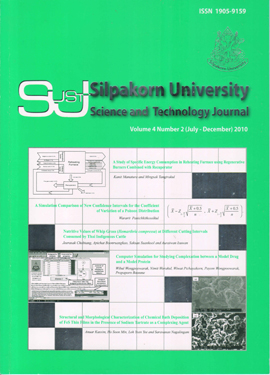Structural and Morphological Characterization of Chemical Bath Deposition of FeS Thin Films in the Presence of Sodium Tartrate as a Complexing Agent
Main Article Content
Abstract
In this paper, we presented the results of X-ray diffraction and scanning electron microscopy of the ironsulphide thin films prepared using a simple and cost effective chemical bath deposition method. The effectsof solution concentration and pH on the structural and morphological properties of thin films were studiedin the presence of sodium tartrate as a complexing agent. The thin films deposited using higher solutionconcentration showed higher number of FeS peaks and larger grain size according to X-ray diffraction andscanning electron microscopy results, respectively as compared with other solution concentrations. On theother hand, when the thin films were deposited at higher pH, the number of FeS peaks reduced to two peaksand the films showed incomplete coverage of material over the surface of the substrate with the smaller grainsize.
Downloads
Article Details
References
Anuar, K., Tan, W. T., Dzulkefly, K. A., Atan, M. S., Ho, S. M., Gwee, S. Y. and Saravanan, N. (2010). Preparation and characterization of FeS2 thin films by chemical bath deposition method. Indonesian Journal of Chemistry, 10: 8-11.
Birkholz, M., Lichtenberger, D., Hopfner, C. and Fiechter, S. (1992). Sputtering of thin pyrite films. Solar Energy Materials and Solar Cells, 27: 243-251.
Bronold, M., Kubala, S., Pettenkofer, C. and Jaegermann, W. (1997). Thin pyrite (FeS2) films by molecular beam deposition. Thin Solid Films, 304: 178-182.
Ferrer, I. J., Nevskaia, D. M., Heras, C. and Sanchez, C. (1990). About the band gap nature of FeS as determined from optical and photoelectrochemical measurements. Solid State Communications, 74: 913-916.
Gumus, C., Ulutas, C. and Ufuktepe, Y. (2007). Optical and structural properties of manganese sulfide thin films. Optical Materials, 29: 1183-1187.
Kale, R. B., Lokhande, C. D., Mane, R. S. and Han, S.H. (2007). Cd0.5Zn0.5Se wide range composite thin films for solar cell buffer layer application. Applied Surface Science, 253: 3109-3112.
Keller-Besrest, F. and Collin, G. (1990). Structural aspects of the a transition in stoichiometric FeS: Identification of the high temperature phase. Journal of Solid State Chemistry, 84: 194-210.
Larramendi, E. M., Calzadilla, O., Arias, A. G., Hernandez, E. and Garcia, J. R. (2001). Effect of surface structure on photosensitivity in chemically deposited PbS thin films. Thin Solid Films, 389: 301-306.
Mane, R. S., Todkar, V. V. and Lokhande, C. D. (2004). Low temperature synthesis of nanocrystalline As2S3 thin films using novel chemical bath deposition route. Applied Surface Science, 227: 48-55.
Moualkia, H., Hariech, S. and Aida, M. S. (2009). Properties of CdS thin films grown by chemical bath deposition as a function of bath temperature. Materials Science Forum, 609: 243-247.
Nakamura, S. and Yamamoto, A. (2001). Electrodeposition of pyrite (FeS2) thin films for photovoltaic cells. Solar Energy Materials and Solar Cells, 65: 79-85.
Thomas, B., Ellmer, K., Muller, M., Hopfner, C., Fiechter, S. and Tributsch, H. (1997). Structural and photoelectrical properties of FeS2 (Pyrite) thin films grown by MOCVD. Journal of Crystal Growth, 170: 808-812.
Ubale, A. U., Sangawar, V. S. and Kulkarni, D. K. (2007). Size dependent optical characteristics of chemically deposited nanostructured ZnS thin films. Bulletin of Materials Science, 30: 147-151.
Willeke, G., Blenk, O., Kloc, C. H. and Bucher, E. (1992). Preparation and electrical transport properties of pyrite (FeS2) single crystals. Journal of Alloys and Compounds, 178: 181-191.


